MENUMENU
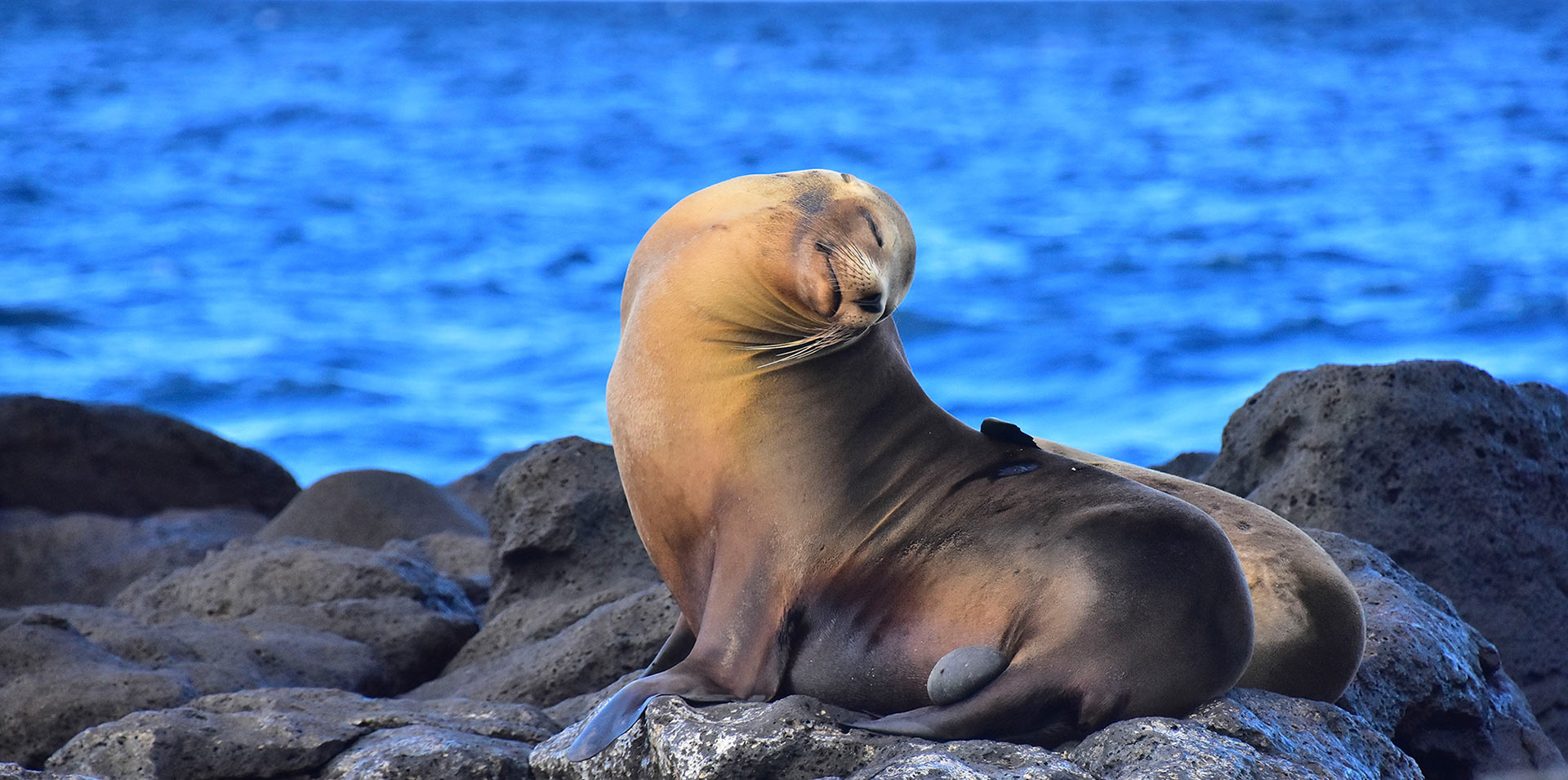
Reading time: 15 mins
The Galapagos archipelago is home to 13 large islands and 6 smaller islands. An abundance of islets and rocky landings spread across the ocean’s 17,000 square miles (45,000 square kilometers). As you might imagine, exploring this great expanse might initially sound daunting, but fear not! In this blog, we’ve conveniently narrowed down this immense area—and its visitor sites—into just over a dozen of the best islands you won’t want to miss out on when visiting the Galapagos!
The list below includes a breakdown of each island’s respective visitor site(s), activities, and cool creatures you’ll want to keep an eye out for! You’ll also be able to see which itineraries you’ll be able to see them on. Take a look at the best islands to visit in Galapagos!
Almost directly south of San Cristobal is another stunning island, Española, which is undoubtedly one of the best islands to visit in the Galapagos. Here are two sites on our list of the best places to visit in the Galapagos: Gardner Bay and Punta Suarez. Unlike Santa Cruz and San Cristobal Islands, Española has no human population, but it is home to the waved albatross, the largest marine bird in the east Pacific, mainly visible from March through December, don’t lose the opportunity to explore one of the best places to visit in Galapagos Islands.
This one of the best islands to visit in Galapagos is known primarily for its incredible species and unique ecosystems. That said, it is also rather popular for its pristine beaches. Upon landing at Gardner Bay, along the northern edge of Española, one begins to understand why the archipelago’s beaches are so attractive. The crystalline waters gently lapping along the white-sand shores of the bay is something to behold.
As visitors freely walk along the long stretch of beach, they spot many sea lions, maybe even curious Española Mockingbirds, Galapagos-top-predator, the Galapagos hawk, and the large cactus finch, a stunning blackbird and the largest of its species, which happens to be endemic to Española.
The western tip of Española is where you’ll find Punta Suarez. This site is wildly popular among nature enthusiasts from all over the world. Here you can observe enormous colonies of sea birds, including Nazca and blue-footed boobies, albatrosses, swallow-tailed gulls, and more! The visitor trail takes you along an elevated volcanic terrain where you’ll encounter colorful marine iguanas and the largest lava lizards. Along the cliff-laden shores of Punta Suarez, you’ll see the famous “blowhole,” a natural rock formation that manifests the effect of its namesake, channeling and shooting up the ocean waves that crash underneath into a stellar spout of mist.
To experience this unique and breathtaking scenery to the fullest, consider planning your visit during the best time to visit Galapagos that aligns with the optimal wildlife viewing opportunities
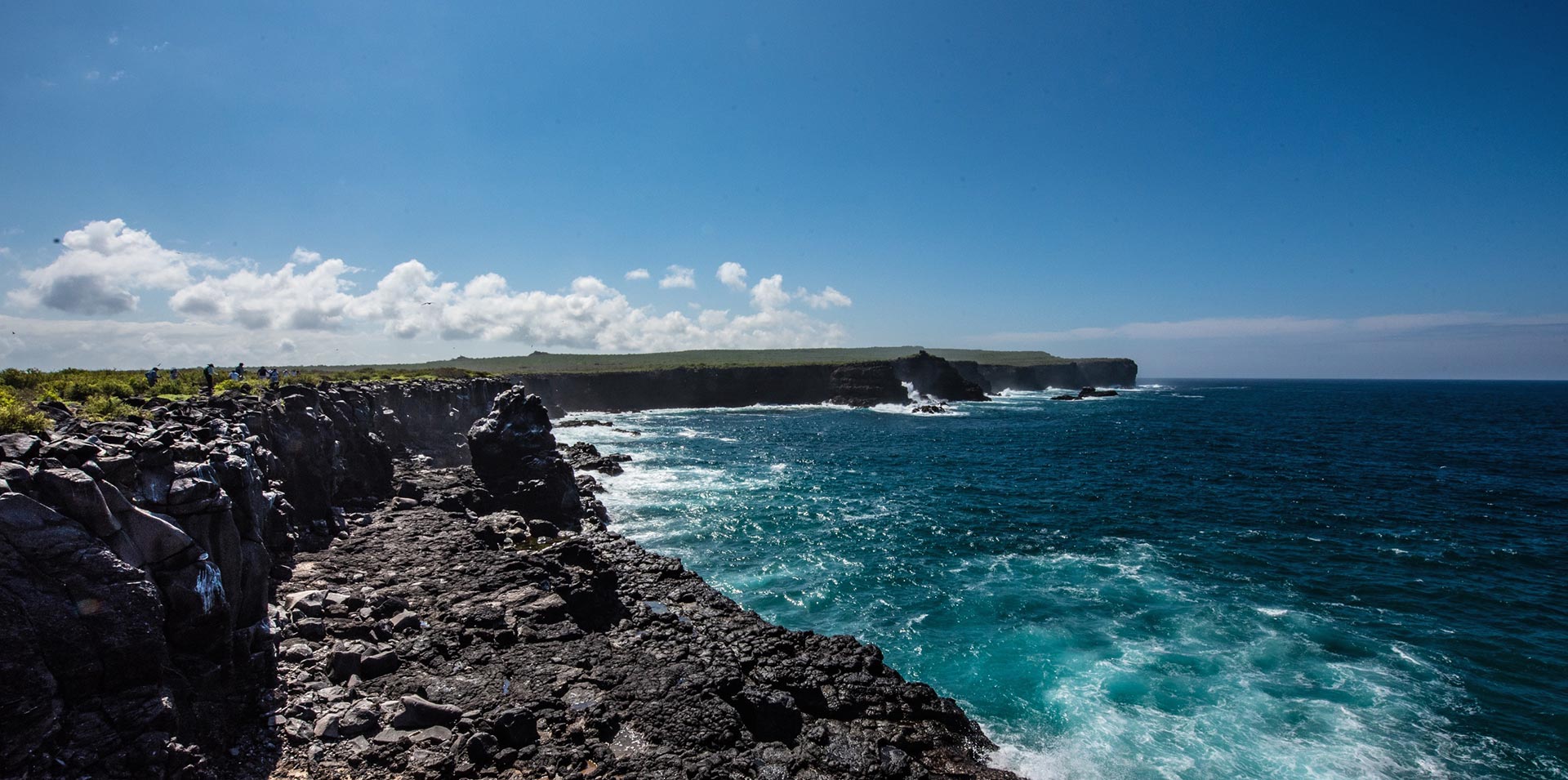
Punta Suarez in Española Island, Galapagos, Ecuador
Southeastern Itinerary: 7 days/6 nights: Gardner Bay and Punta Suarez
Eastern Galapagos Itinerary: 5 Days / 4 Nights
The western most island in the Galapagos is Fernandina, sitting opposite the western shores of Isabela, just across the Bolivar Channel. The island is the youngest in the archipelago, and its La Cumbre Volcano is perhaps the most active, with significant eruptions taking place in 2017, 2018, and 2020. The island features two National Park visiting sites and two diving sites, C Hammond y C Douglas. The first of these visiting sites is Punta Mangle.
The Bolivar Channel runs between the western and eastern shores of Isabela and Fernandina Islands, respectively. Punta Mangle, one of the best places to visit in Galapagos Islands, is located along the southeastern shores of Fernandina. There is no landing opportunity here, but plenty to see from the comfort of our pangas. Visitors are instead invited to explore the island’s mangrove-rich and rocky shores—featuring the curious and colorful lava cactus—aboard a panga (or dinghy). Fortunately, there is an inlet that is ideal for snorkeling. Galapagos penguins, marine iguanas, rays, sea lions, and more inhabit these waters, and you can view them just beneath the surface. Galapagos penguins, marine iguanas, hawks, sea lions, rays, turtles, and pelicans make these mangrove ecosystems their home.
Along the northern shore of Fernandina, just beyond the Bolivar Channel, you’ll find Punta Espinoza, one of the best places to visit in Galapagos Islands. As your certified naturalist guide will point out as you wind your way along a small peninsula or further inland to the edge of a lava flow, Punta Espinoza is home to flightless cormorants, marine iguanas, Galapagos penguins, sea lions, and plenty more. Here, too, you’ll see the unique lava cactus, which grows on lava rock and survives on very little water.
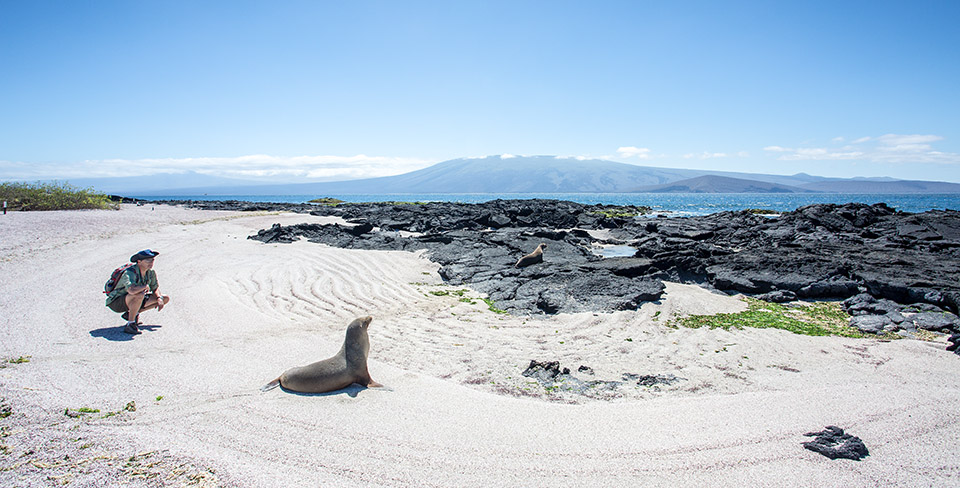
Fernandina Island, Galapagos
Southeastern Itinerary: 7 days/6 nights: Punta Mangle
Western Itinerary: 5 days/4 nights: Punta Espinoza
Western Galapagos Itinerary: 7 Days / 6 Nights
Baltra, the airport Island – has another name, South Seymour Island. One of the best islands to visit in Galapagos is just north of it; you’ll find North Seymour Island. This popular site is home to one of the largest non-endemic populations of land iguanas, relocated here from Baltra Island almost 100 years ago. This was done to protect the iguanas from goats introduced on Baltra. Today, these iguanas share the island with the Galapagos’ largest colony of magnificent frigatebirds. The island is relatively flat, though the trail is exciting, thanks to all the wildlife activity. Visitors are bound to see the inflated red gular sacs of male frigatebirds and a colony of blue-footed boobies, as well as basking Galapagos sea lions and Galapagos fur seals. A total of 7 BIG15!
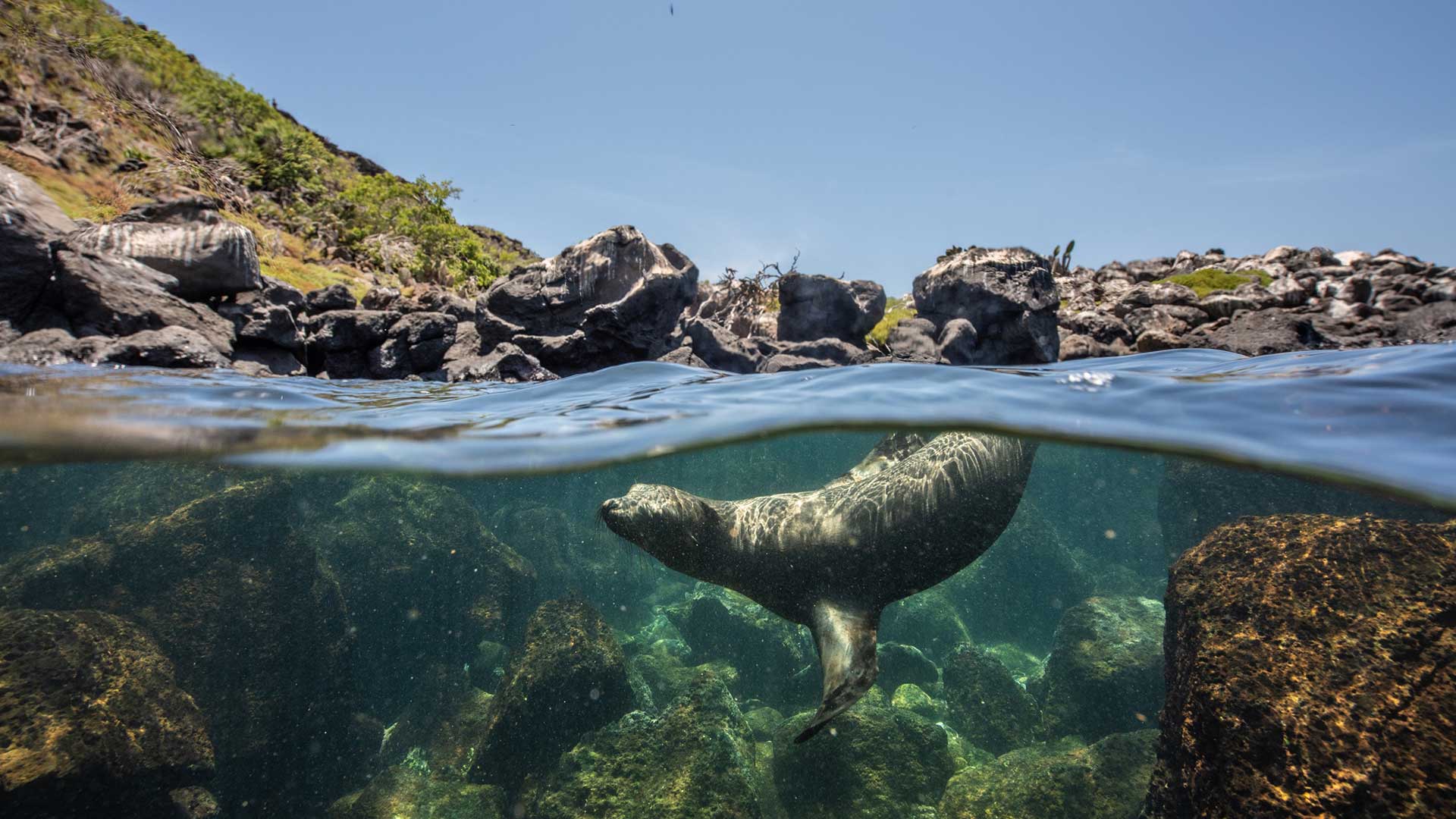
Sea Lion in North Seymour Island
Southeastern Itinerary: 7 days/6 nights: North Seymour Island
Western Galapagos Itinerary: 7 Days / 6 Nights
Located in the northeastern quadrant of the Galapagos, Genovesa Island is fairly removed from the central hub of Santa Cruz. The island holds an attractive contour, given that a side of the lip of this massive shield volcano collapsed at one time and, in doing so, submerged part of the island and formed Darwin Bay in the process. These days, it is home to many seabirds, including swallow-tailed gulls, Galapagos storm petrels, red-footed boobies, Nazca boobies, mockingbirds, finches, and more!
In keeping with the theme of Genovesa Island, the south-facing Darwin Bay, is a world of seabirds unto itself. If you consider the bay a ¾ crescent, most are rocky shores and cliffs, and only a tiny fraction is the beach; it is one of the places to visit in the Galapagos islands. However, it is here where a serene walk along the small white sands is an opportunity to observe frigatebirds, Nazca and red-footed boobies, herons, gulls, finches, mockingbirds, and more against the backdrop of prickly pear cacti and palo santo trees. The morning excursion will include snorkeling along the crater walls. You’ll see impressive reef fish amongst Galapagos- fur seals and sea lions.
Named in honor of a visit by Prince Philip in the mid-1960s, these famous “steps,” comprised of slabs and rocks with a man-made handrail, make it possible to climb to the top of an 82-foot (25-meter) cliff. Located along the southern peninsula of Genovesa Island, opposite the beach at Darwin Bay. Prince Philip’s Steps are accessible via panga. This is one of the steepest climbs and a rather challenging experience for visitors—but very worthwhile! Once on the plateau, we will pass the nesting area of Nazca and red-footed boobies until we reach the impressive colony of Galapagos storm petrels. Here we look out for the island’s only bird of prey, the diurnal Galapagos short-eared owl.
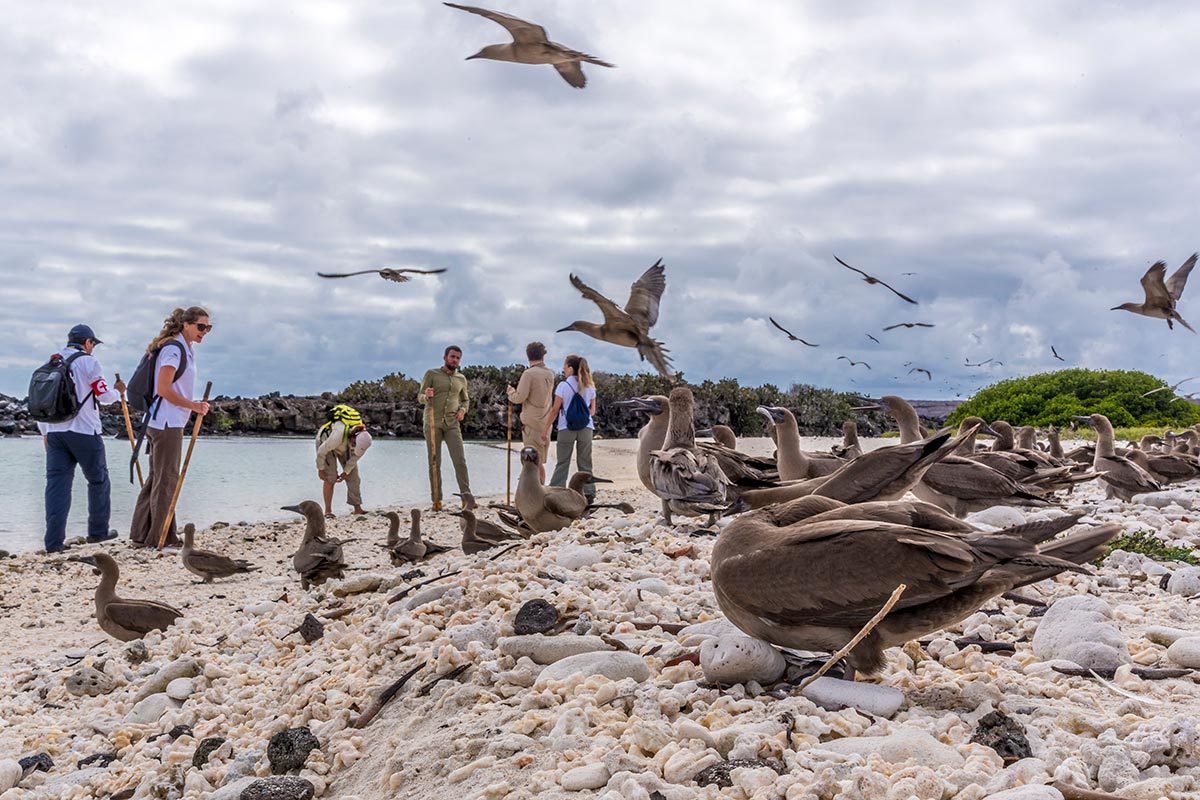
Tourists in Darwin Bay, Genovesa Island
Northern Itinerary: 5 days/4 nights: Darwin Bay, Prince Philip’s Steps
Northern Galapagos Itinerary: 5 Days / 4 Nights
Isabela Island is a fascinating place in the Galapagos. It is the largest and youngest island in the archipelago and was formed by the activity of six shield volcanoes. Many of these have been active over the years, including Wolf—located at the northernmost tip of Isabela Island, which erupted as recently as 2022.
The third largest human population (approximately 1,800) resides in the southern coastal town of Puerto Villamil. The island is about 75 miles (120 kilometers) in length. Yet, the only access to this island is via boat if traveling aboard a small inter-island aircraft.
When touring the Galapagos aboard an expedition vessel, you’re more likely to visit the treasured and remote Isabela sites. Two prominent ones are worth noting. The first is the northwest-facing Punta Moreno, located on the western shores of Isabela’s southern coast, near one end of the Bolivar Channel.
What makes Punta Moreno such an interesting site is the presence of black lava rock, a reminder of its location at the base of Cerro Azul, one of Isabela’s six volcanos. Amid the surrounding terrain are several lagoons brimming with wildlife. Visitors can see white-cheeked pintails, American flamingos, hawks, and paint-billed crakes here. As the rough terrain, much care should be taken when traversing the path from the shore to the lagoons.
The panga ride through a labyrinth of lava and mangrove, where we see large groups of marine iguanas, Galapagos penguins, flightless cormorants, and pelicans. If you like to hike, the trail over the lava leads us to small brackish lagoons that look like an oasis in the desert: green and lush vegetation all year round and habitat for white-cheeked pintails, gallinules, etc.
In addition to these lagoons, there are three types of cacti and some impressive Scalesia trees. Wildlife is prevalent. Visitors can often view Galapagos penguins, flightless cormorants, brown pelicans, herons, sea lions, marine iguanas, Sally Lightfoot crabs, common stilts, and Galapagos hawks, among others.
Compared to many other sites within the Galapagos National Park, Punta Vicente Roca is not a landing site. Here, exploration is done via panga (or dinghy). At this location are colonies of Galapagos fur seals, numerous nests of Nazca boobies, gulps of flightless cormorants, and plenty of Galapagos penguins, sea turtles, and marine iguanas to keep your eyes busy.
Because the Cromwell Current is responsible for upwelling in this channel, the water tends to be more relaxed than in other locations. However, this also means abundant nutrients are available for marine species; thus, snorkeling here is quite exciting! It is not uncommon to see whales and dolphins feeding in this vicinity.
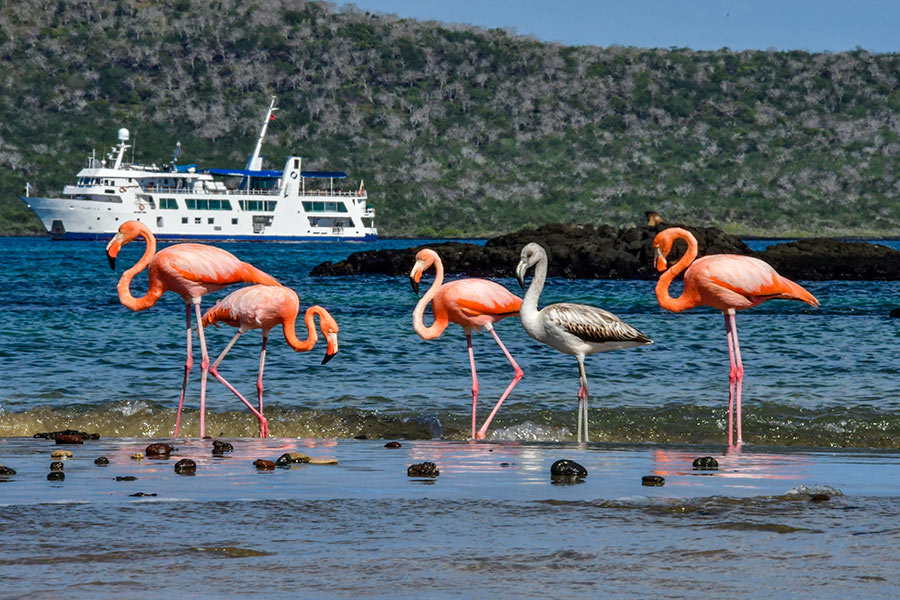
Flamingos in Galapagos Islands
Southeastern Itinerary: 7 days/6 nights: Punta Moreno
Western Itinerary: 5 days/4 nights: Punta Vicente Roca
Western Galapagos Itinerary: 7 Days / 6 Nights
Just off the eastern coast of Santiago Island, you’ll find one of the most beloved tiny islets in the archipelago. Arguably, the most photographed place in Galapagos, Bartolome Island, features one of the most stupendous panoramic views from one of its sloping hills. From here, one can see many of Santiago’s undulating hills and the beautiful bay beside the ever-impressive Pinnacle Rock, a stunning volcanic cone home to a small colony of Galapagos penguins. To get to this scenic viewpoint, visitors make their way up a trail with a wooden staircase with 360 steps (with plenty of resting “balconies”), extending 1,969 feet (600 meters). It is every bit worth the effort!
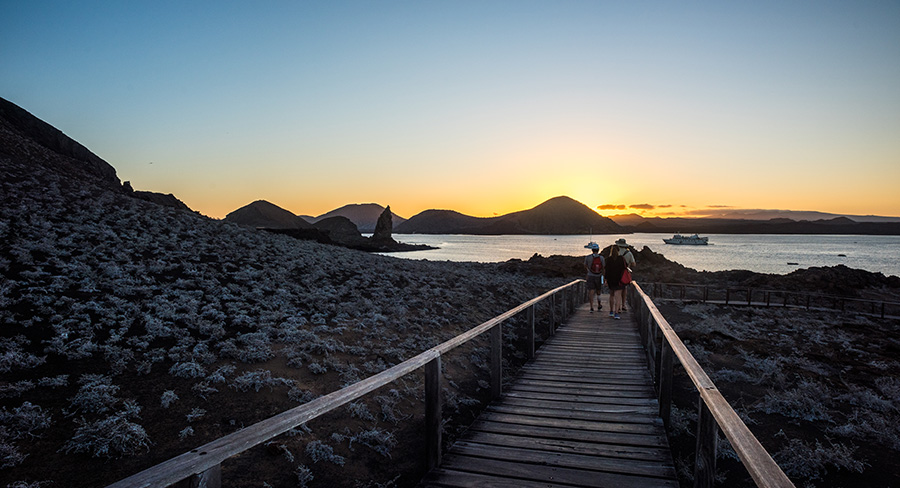
Wooden path on Bartolome Island, Galapagos
Western Itinerary: 5 days/4 nights: Bartolome Island
Northern Galapagos Itinerary: 5 Days / 4 Nights
In the center of the archipelago, we have Santiago Island. Historically, this island was one of the most exploited by buccaneers, whalers, and tortoise catchers; it even had a salt mine, which can be visited from Puerto Egas.
The devastation caused by humans would be felt for the better part of two centuries. The giant tortoise population was all but decimated by man, who also introduced rodents, goats, donkeys, and swine to the island, each of which had a disastrous effect on the ecosystems. It would take nearly 200 years for rodents, pigs, and other invasive species to be removed from Santiago Island finally.
Since then, the Galapagos National Park has made great strides in recovering the land iguana population and supporting the remaining giant tortoises. Today, Santiago Island is one of the archipelago’s most well-protected and carefully visited islands, with three popular sites, so this is one of the best islands to visit in Galapagos.
Located on the western shores of Santiago Island, in a harbor called James Bay, the visitor site at Puerto Egas offers two distinct trails. A different path takes you along the rocky coast to grottoes, where fur seals abound. In either case, the experience is one of a kind! Puerto Egas was voted as one of the Galapagos‘ best shoreline experiences. The trail combines layers of tuff stone (volcanic ash mixed with seawater produces sedimentary rock) and pahoehoe lava. As the tide recedes, myriads of tide pools are left behind, each filled with intertidal organisms. Then you encounter “carpets” of basking marine iguanas, thousands of sally lightfoot crabs, land-going fish (the four-eyed-blenny), and Galapagos sea lions and fur seals. The inland portion of the trail is a habitat for Galapagos doves, Darwin finches, Galapagos hawks, and land iguanas.
Voted as one of Galapagos‘ best shoreline experiences. The trail combines layers of tuff stone (volcanic ash mixed with seawater produces sedimentary rock) and pahoehoe lava. As the tide recedes, myriads of tide pools are left behind, each filled with intertidal organisms. Then you encounter “carpets” of basking marine iguanas, thousands of sally lightfoot crabs, land-going fish (the four-eyed-blenny), and Galapagos sea lions and fur seals. The inland portion of the trail is a habitat for Galapagos doves and Darwin finches, as well as Galapagos hawks and land iguanas.
Along the northwestern corner of Santiago Island, Buccaneer Cove reminds us of why it got its name. This was where many explorers and adventurers sought refuge to stock up on supplies, rest, and prepare for their next excursion. Today, its mighty cliffs are home to the incredible marine birds that inhabit its remarkable natural formations, such as Elephant Rock and The Bishop—an impressive natural cave. Visitors can tour the red-sand shoreline aboard a panga (dinghy) or glass-bottom boat. Snorkeling is also an activity that visitors can enjoy here.
Sullivan Bay is located off the eastern coast of Santiago Island. Here, the scenery is truly otherworldly. The white-coral sand beach makes for terrific swimming. The surrounding fields of lava rock are rather barren but impactful. To visit Sullivan Bay is to understand the Galapagos Island’s volcanic origins.
Today this is one of the most surreal trails to see the relatively young pahoehoe lava flows and the intricate shapes they took when solidifying. Galapagos Penguins, Galapagos Hawks, and Galapagos Sea lions are part of this site’s experience.
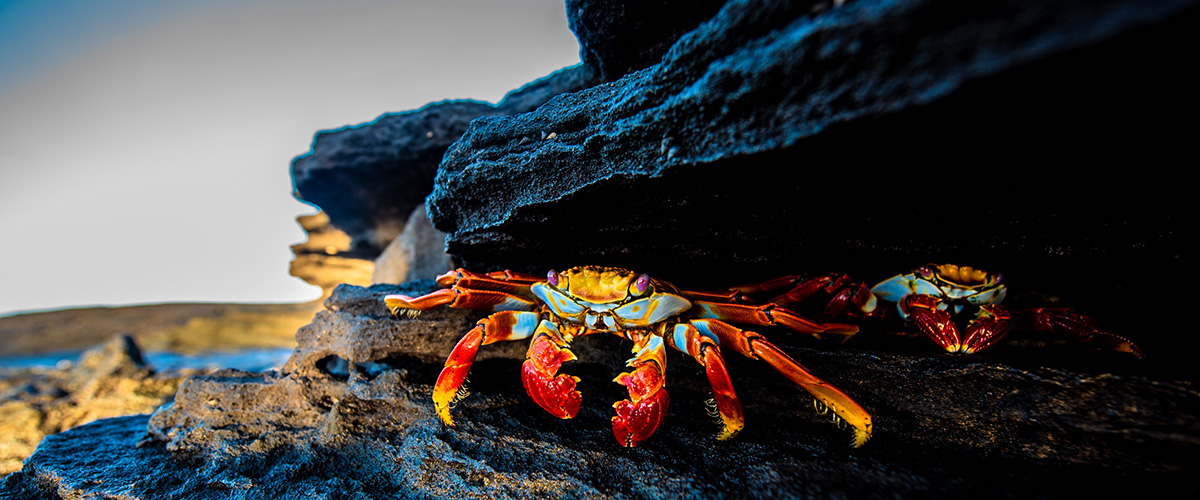
Zayapa in Cerro Brujo, San Cristobal Island
Western Itinerary: 5 days/4 nights: Sullivan Bay, Buccaneer Cove
Northern Itinerary: 5 days/4 nights: Puerto Egas
Santiago Island is accessible via the following itineraries aboard Yacht Isabela II: Western – 5 days/4 nights: Sullivan Bay, Buccaneer Cove
Northern – 5 days/4 nights: Puerto Egas
Northern Galapagos Itinerary: 5 Days / 4 Nights